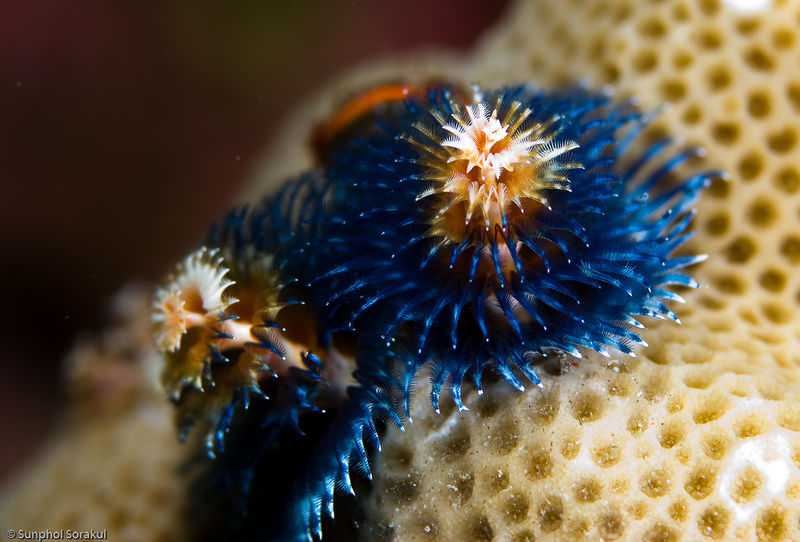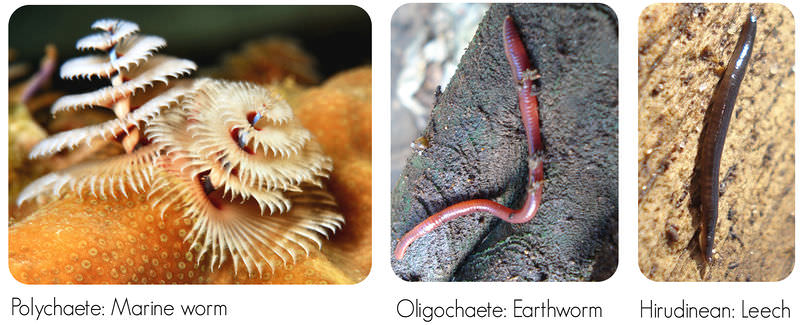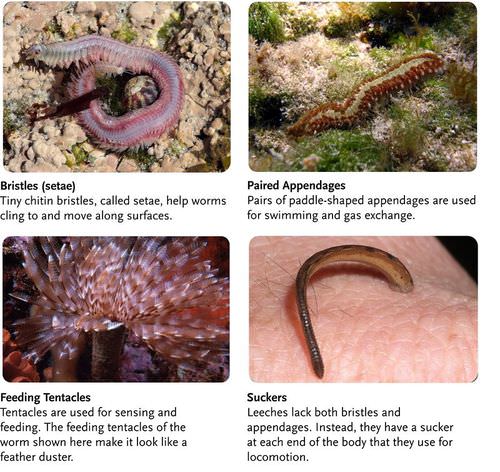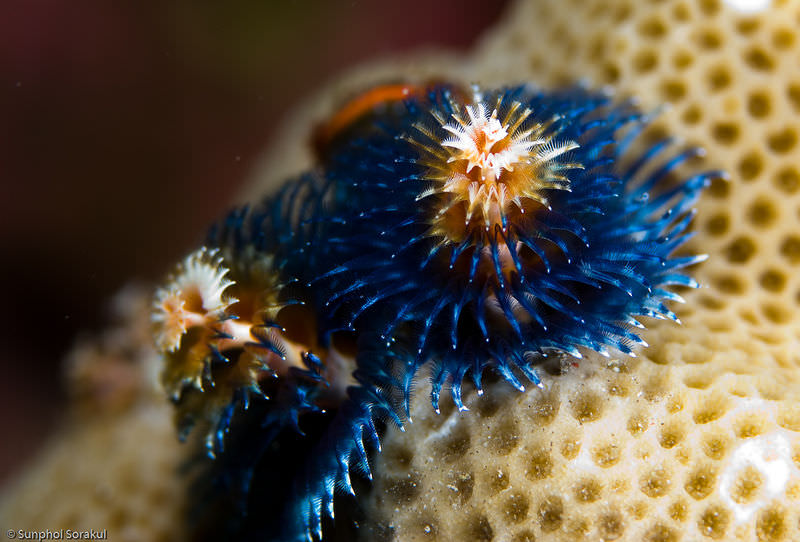11.13: Annelids
- Page ID
- 12256

How can this be an animal?
This is a worm. And even though it is blue, this is a Christmas tree worm. These "Christmas tree" structures are actually specialized mouth appendages. Each spiral is composed of feather-like tentacles which are heavily ciliated. These appendages trap prey and transport the food straight towards the worm's mouth. And these worms are annelids.
Annelids
The phylum Annelida is made up of segmented worms such as earthworms. Segmented worms are divided into many repeating segments. There are roughly 15,000 species of annelids. Most belong to one of three classes. A species in each class is pictured in Figure below.
 Classes of Annelids. The majority of annelids are polychaetes. They live on the ocean floor, so you may not be familiar with them.
Classes of Annelids. The majority of annelids are polychaetes. They live on the ocean floor, so you may not be familiar with them.Structure and Function of Annelids
Annelids range in length from less than 1 millimeter to over 3 meters. They never attain the large size of some mollusks. Like mollusks, however, they have a coelom. In fact, the annelid coelom is even larger, allowing greater development of internal organs. Annelids have other similarities with mollusks, including:
- A closed circulatory system (like cephalopods).
- An excretory system consisting of tubular nephridia.
- A complete digestive system.
- A brain.
- Sensory organs for detecting light and other stimuli.
- Gills for gas exchange (but many exchange gas through their skin).
The segmentation of annelids is highly adaptive. For one thing, it allows more efficient movement. Each segment generally has its own nerve and muscle tissues. Thus, localized muscle contractions can move just those segments needed for a particular motion. Segmentation also allows an animal to have specialized segments to carry out particular functions. This allows the whole animal to be more efficient. Annelids have the amazing capacity to regrow segments that break off. This is called regeneration.
Annelids have a variety of structures on the surface of their body for movement and other functions. These vary, depending on the species. Several of the structures are described in Figure below.
 Annelid External Structures. Many annelids have bristles and other types of external structures. Each structure is not present in all species.
Annelid External Structures. Many annelids have bristles and other types of external structures. Each structure is not present in all species.Annelid Reproduction
Most species of annelids can reproduce both asexually and sexually. However, leeches can reproduce only sexually. Asexual reproduction may occur by budding or fission. Sexual reproduction varies by species.
- In some species, the same individual produces both sperm and eggs. But worms mate to exchange sperm, rather than self-fertilizing their own eggs. Fertilized eggs are deposited in a mucous cocoon. Offspring emerge from the cocoon looking like small adults. They grow to adult size without going through a larval stage.
- In polychaete species, there are separate sexes. Adult worms go through a major transformation to develop reproductive organs. This occurs in many adults at once. Then they all swim to the surface and release their gametes in the water, where fertilization takes place. Offspring go through a larval stage before developing into adults.
Ecology of Annelids
Annelids live in a diversity of freshwater, marine, and terrestrial habitats. They vary in what they feed on and how they obtain their food.
- Earthworms are deposit feeders. They burrow through the ground, eating soil and extracting organic matter from it. Earthworm feces, called worm casts, are very rich in plant nutrients. Earthworm burrows help aerate soil, which is also good for plants.
- Polychaetes live on the ocean floor. They may be sedentary filter feeders, active predators, or scavengers. Active species crawl along the ocean floor in search of food.
- Leeches are either predators or parasites. As predators, they capture and eat other invertebrates. As parasites, they feed off the blood of vertebrate hosts. They have a tubular organ, called a proboscis, for feeding.
Comparison of Worms
The following table compares the three worm phyla (Table below).
| Phylum | Common Name | Body Cavity | Segmented | Digestive System | Example |
|---|---|---|---|---|---|
| Platyhelminthes | Flatworm | No | No | Incomplete | Tapeworm |
| Nematoda | Roundworm | Yes | No | Complete | Heartworm |
| Annelida | Segmented worm | Yes | Yes | Complete | Earthworm |
Summary
- Annelids are segmented worms such as earthworms and leeches.
- Annelids have a coelom, closed circulatory system, excretory system, and complete digestive system. They also have a brain.
- Earthworms are important deposit feeders that help form and enrich soil.
- Leeches are either predators or parasites. Parasitic leeches feed off the blood of vertebrate hosts.
Review
- Discuss the advantages of segmentation.
- Define regeneration.
- Polychaete worms have an interesting reproductive strategy. Describe this strategy and infer its adaptive significance.
- What are deposit feeders?
| Image | Reference | Attributions |
 |
[Figure 1] | Credit: Bristles: Deryk Tolman; Paired appendages: User:C-Ack/Wikipedia; Feeding tentacles: Courtesy of Chris Gotschalk/National Oceanic and Atmospheric Administration; Suckers: Frank Vassen;Kerry Wixted Source: Bristles: http://www.flickr.com/photos/derykt/5743856993/ ; Paired appendages: commons.wikimedia.org/wiki/File:Bearded_Fireworm_%28Small%29.jpg ; Feeding tentacles: commons.wikimedia.org/wiki/File:Featherduster_300.jpg ; Suckers: http://www.flickr.com/photos/42244964@N03/11916858975/ ; http://www.flickr.com/photos/kwixted0/190882258/ License: CC BY-NC |
 |
[Figure 2] | Credit: Marine worm: Laszlo Ilyes; Earthworm: Flickr:net_efekt; Leech: Mick Talbot;By WYassineMrabetTalk✉This vector image was created with Inkscape. - Own work, CC BY-SA 3.0, commons.wikimedia.org/w/inde...rid=8062105;By User Necrophorus on de.Wikipedia - Foto: de:Benutzer:Necrophorus, CC BY-SA 3.0, commons.wikimedia.org/w/inde...?curid=1037045 Source: Marine worm: http://www.flickr.com/photos/laszlo-photo/5287830740/ ; Earthworm: http://www.flickr.com/photos/wheatfields/3409167144/ ; Leech: http://www.flickr.com/photos/micks-wildlife-macros/3382088779/ ; By WYassineMrabetTalk✉This vector image was created with Inkscape. - Own work ; CC BY-SA 3.0 ; commons.wikimedia.org/w/index.php?curid=8062105 ; By User Necrophorus on de.Wikipedia - Foto: de:Benutzer:Necrophorus ; CC BY-SA 3.0 ; commons.wikimedia.org/w/index.php?curid=1037045 License: CC BY 2.0 |
 |
[Figure 3] | Credit: Bristles: Deryk Tolman; Paired appendages: User:C-Ack/Wikipedia; Feeding tentacles: Courtesy of Chris Gotschalk/National Oceanic and Atmospheric Administration; Suckers: Frank Vassen Source: Bristles: http://www.flickr.com/photos/derykt/5743856993/ ; Paired appendages: commons.wikimedia.org/wiki/File:Bearded_Fireworm_%28Small%29.jpg ; Feeding tentacles: commons.wikimedia.org/wiki/File:Featherduster_300.jpg ; Suckers: http://www.flickr.com/photos/42244964@N03/11916858975/ License: Bristles CC BY 2.0; Paired Appendages CC BY 2.5; Feeding tentacles Public Domain; Suckers CC BY 2.0 |

